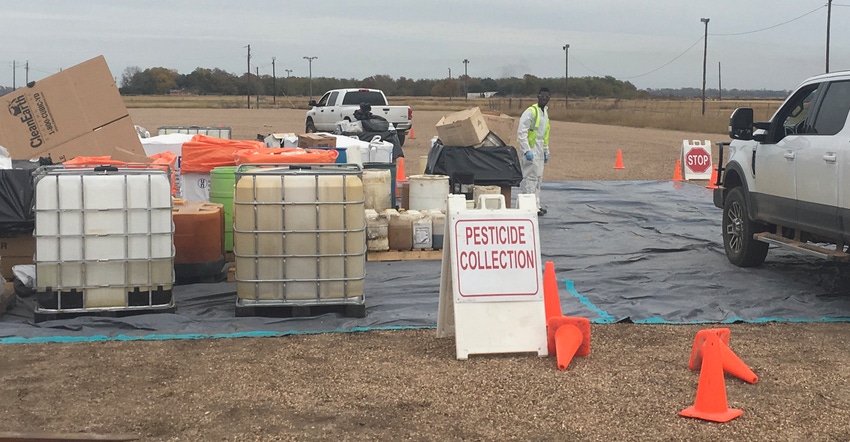December 17, 2018

With half-empty containers of pesticide stacking up in barns, farmers in the Wharton County area were patiently waiting for the opportunity for responsible disposal as part of being good land stewards, according to experts.
Pesticide applicators generate and accumulate a significant amount of pesticide waste in the form of empty containers and unused pesticides. Pesticides become unused when they are either unregistered for use by the Environmental Protection Agency or become unidentifiable when product labels deteriorate or separate from containers.
The opportunity for appropriate disposal came recently as the Texas A&M AgriLife Extension Service led an effort under the direction of its Wharton County Leadership Advisory Board. They were joined by the Texas Department of Agriculture and Texas Commission on Environmental Quality for a daylong pesticide collection event at the Wharton County Fairgrounds.
Program returns
It marked the first such event after a 10-year absence and featured representatives of the multiple agencies helping design, facilitate and coordinate the removal of unwanted pesticides and pesticide containers.
“Pesticide collection activities were once commonplace in counties across our state, as AgriLife Extension agents, along with their counterparts in the TDA and TCEQ would host waste collection days for ag producers to dispose of unused pesticides and pesticide containers,” said Dr. Philip Shackelford, AgriLife Extension regional program leader in College Station.
“However, due to a shift in priorities and a perpetual lack of funding, these pesticide collection events were discontinued,” he said. “Subsequently, many producers were forced to store unused pesticides and pesticide containers, oftentimes for many years without a method of disposing of them that was cost-effective.”
Contamination risk
Following the devastation caused by Hurricane Harvey, and the subsequent flooding that ensued, leftover products posed a huge contamination risk to groundwater and surface water as hundreds of farmsteads in Southeast Texas were flooded, Shackelford said.
“In the aftermath of the flooding, it was apparent that these unwanted and unused pesticides needed to be disposed of properly and in a safe manner,” he said.
Area producers serving on the Wharton County Leadership Advisory Board further identified the need for collection activities. Corrie Bowen, AgriLife Extension agent for ag and natural resources, worked with Texas A&M AgriLife Extension Agricultural and Environmental Safety, agency partners in the Texas Department of Agriculture, local state Rep. Phil Stephenson (R-Wharton), and industry partners to establish a pesticide waste collection activity.”
The event was held at the Wharton County Fairgrounds. More than 121,836 pounds of pesticide waste was collected, which included 21,305 pounds of solid pesticide/herbicide waste, 35,041 pounds of pesticides liquids bulked into either totes or various sized drums, and 61,023 pounds of pesticide and herbicide liquid in small jugs less than 5 gallons.
Disposal
“This waste was transported in three semi-trucks back for disposal to a facility in Houston,” Shackelford said. “The average cost for the 114 vehicles that dropped off product would have been roughly $1,582.12 for disposal. In all, total savings were estimated at $180,361.68. This does not include any transportation or labor charges, so the total average per vehicle would be close to $2,000, making the estimated total savings for producers in the seven-county area that was targeted about $228,000.”
“This was AgriLife Extension programming at its best,” Bowen said. “We have been and will continue to educate ag producers on the proper use and disposal of pesticides and pesticide waste products, however without events such as this, proper disposal can become an expensive and cumbersome task.”
Shackelford said with the support of the TDA and AgriLife Extension, “We are hoping that this activity will lay the groundwork for future pesticide waste collection activities that could be conducted across our state.”
Bowen said surveys completed by producers while they dropped off their waste pesticides show that 47 percent (55 of 117) had been storing their unused pesticides for over eight years, waiting for proper disposal; 44 percent for five to eight years; 8 percent for one to three years.
Statewide need
“There is a tremendous need for statewide collections as pesticide waste products stack up,” he said. “The success of this pesticide collection event verifies the tremendous need of coordinated collection activities in Texas.”
About the Author(s)
You May Also Like




